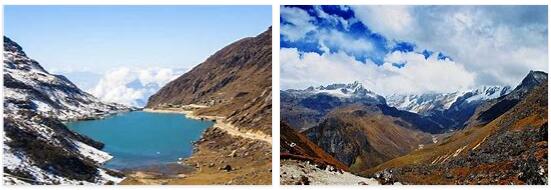
Sikkim is almost unknown as a travel destination and only a few know anything about the small mountain state measuring around 7,300 square kilometers in the east of the Himalayas, which borders the Indian West Bengal, Nepal, Tibet and the Kingdom of Bhutan. Even if the area is not particularly large, the nature and culture of Sikkim still allow holidays with many different impressions – not least because the mountain state was once a kingdom, then a British protectorate, and joined the Indian Union in 1975. Alpinists may be familiar with Sikkim because of the 8,586 m high Kangchenjunga, the third highest mountain on earth, or with peaks that are covered by snow all year round. Culturally interested people may be familiar with Sikkim through its capital Gangtok, which the Enchey Monastery has developed from a small town to a bustling town and a well-known place of pilgrimage since it was founded. Gangtok is located on the foothills of the Himalayas in the populated southeast of the state and is particularly architecturally worth seeing for its pagoda-like wooden houses with turquoise roofs. A visit to the Institute of Tibetology is also worthwhile, but above all because of said monastery. The holiest of all monasteries is Tashding, about 40 km from Gezing, located between two rivers on a hill and decorated with gold. The oldest monastery, on the other hand, is Yuksom. However, you will also encounter Hindu temples in Sikkim. The most famous of them is Thakurbari in the heart of Gangtok. About 14 km south of the capital, another, other worth seeing in Sikkim: the Samsara gardens and an orchidarium.
Pemayangtse
The Pemayangtse Monastery is a Buddhist monastery in Pemayangtse, near Pelling in the northeast Indian state of Sikkim. The monastery was planned, designed and founded by Lama Lhatsun Chempo in 1705. It is one of the oldest and most important monasteries of Sikkim, also the most famous one in West Sikkim in India. From the outside as well as from the inside, it is cheerful and colorful. The windows and doors in particular are beautifully decorated. You can even find small Tibetan paintings on them. The monastery complex is located on a hill with a view of the ruins of Rabdentse and is full of historical flair. It is surrounded by blooming gardens and brick monks’ huts. There is an extensive model building on the upper floor of the monastery.
Visitors to the Pemayangtse Monastery shouldn’t miss the Cham dances earlier this year. The Losar Dance Festival takes place annually on the 28th and 29th day of the 12th lunar month of the Tibetan calendar, also on February of the Gregorian calendar. The festival is performed by the lamas of the monastery, who dress up in colorful costumes for the dance performance. Pilgrims and visitors from all parts of Sikkim visit the monastery to take part in this event. Fireworks are also part of the final festival and symbolize the expulsion of evil spirits.
Vacationers should note that here, as in almost all monasteries in Sikkim, there is an absolute ban on photography. She should respect this out of respect for the monks living here and their faith.
Tashiding Monastery in Sikkim
Numerous sanctuaries in Sikkim and India are shrouded in legends. One such states that Guru Rinpoche, an eighth century Buddhist master, shot an arrow in the air one day. He chose the place where the arrow landed as the place of his meditation. And this is exactly where Tashiding Monastery is today. For the people of Sikkim, this is a sacred place with a monastery that was consecrated to celebrate the traditional Bhumchu festival.
Holy place at an altitude of 1,500 meters
The Tashiding Monastery is located at an altitude of almost 1,500 meters. The third highest mountain in the world, the Kanchendzonga, with its snow-capped peaks forms the impressive backdrop of this sacred place for the believers in Sikkim. It is the spiritual center of the country. The closest place to the 17th century monastery belonging to the Nyingmapa order is called Pemayangtse.
Ancient sculptures and art objects
Valuable antique sculptures and art objects are showpieces of the monastery. The chorten, which are supposed to symbolize the omnipresent consciousness of Buddha and serve the memory of deserving lamas, are particularly venerated. According to the ideas of the people in Sikkim, they should also keep evil spirits away from this holy place. She is convinced that a quick glance at the chorten is enough in tashiding to get rid of all sins.
Prayer flags and colorful prayer halls
If you hike up to the Tashiding monastery and pass the mani walls with their Tibetan characters, which are well worth seeing, you will see the prayer flags from afar. The monastery has a total of five quite colorful halls of worship as well as some simple accommodations for the monks. A golden prayer wheel adorns the center of the complex. Every year Tashiding is dedicated to the Bhumchu ceremony. A three hundred year old vessel is of particular importance. Its water level should provide information on how the fertility of Sikkim is. The monastery is a place where grandiose nature and spirituality meet.